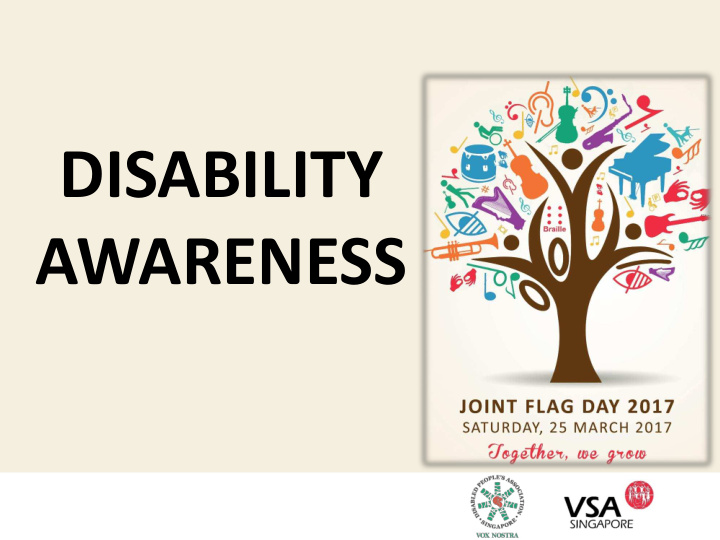



DISABILITY AWARENESS
What is Disability Disability results from the interaction between people with impairments and societal obstacles, such as physical barriers and even people’s attitudes. These barriers can get in the way of a person with disability participating in society. By tackling the barriers in the environment, we can (and should) remove some of the challenges faced by persons with disabilities.
Types of Disability • Physical - affects a person's mobility or dexterity. • Intellectual - affects a person's ability to learn. • Psychiatric - affects a person's thinking processes. • Sensory - affects a person's ability to hear or see. • Neurological - results in the loss of some bodily or mental functions.
Effects of Having a Disability Sometimes the barriers & obstacles that a person with disabilities faces can have the following effects on that person: • Physical • Emotional • Neurodiversity • Societal
Famous People with Disabilities • Ludwig van Beethoven – Deafness • Franklin Roosevelt – Polio, Blindness • Abraham Lincoln – Depression, Asperger’s Syndrome • Bill gates –Asperger’s syndrome • David Beckham – OCD (Obsessive Compulsive Disorder) • Tom Cruise - Dyslexia • Stephen Hawking – Motor Neuron Disease, ALS (amyotrophic lateral sclerosis) • Albert Einstein – Dyslexia, Asperger’s Syndrome • Bruce Willis – Speech Differences • Julia Roberts – Speech Differences • Cameron Diaz - OCD (Obsessive Compulsive Disorder) • Leonardo Di Caprio - OCD (Obsessive Compulsive Disorder) • Muhammad Ali – Parkinson’s Disease • Tiger Woods - Stuttering • Stevie Wonder - Blind and many more…
Disability Etiquette • Communicate in their preferred way. Ask first if you are not sure. • Avoid outdated and negative terms such as ‘handicapped’, ‘wheelchair - bound’, ‘suffering’ from a disability and crippled. Do not use terms like ‘not normal’ or ‘spastic’. • Use more positive terms such as ‘wheelchair user’ and ‘person WITH a disability’.
Disability Etiquette • Ask how you can help. • Look at and speak directly to the person, rather than through a companion or attendant. • Listen attentively when talking to a person who has a speech impairment. Ask the person to repeat what they said if you did not understand the first time.
Disability Etiquette • When talking for more than a few minutes with a person who uses a wheelchair or scooter, use a chair or take a step back to maintain comfortable eye contact. • Do not move a wheelchair, crutches, or other mobility aid out of reach of a person who uses them. • Do not push a mobility aid (such as a wheelchair) without first asking the occupant if you may do so
Disability Etiquette • Do not lean on a person's mobility aid when talking, or pat a person a wheelchair user on the head. • Be alert to the possible existence of barriers in the surrounding environment, such as small doorways, and obstacles in the pathway.
Different Abilities, Not Disabilities
Thank you!
Recommend
More recommend